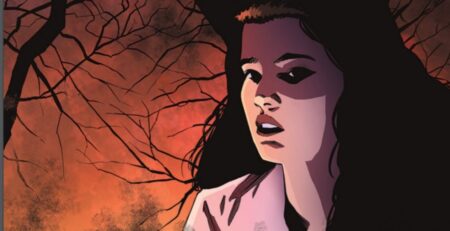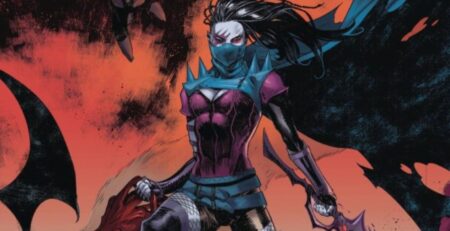
Duplicant #1 is a sci-fi comic created and written by Karla Nappi. Art by Marianna Strychowska. Josh Reed is on lettering/production. The story takes place in a futuristic world where a pandemic of organ failures is causing widespread damage. A company called Regenerist Tech started to develop synthetic organs to match the demand for transplants needed. Those that receive “duplicate” organs not only face massive social stigma, but also crippling debt that is then auctioned off to the highest bidder. Human transplants are now hard to find and on the verge of becoming illegal.
This issue follows Pam, a 30-year-old woman who is given duplicate lungs after her original body parts fail. Forced into receiving the synthetic organs, Pam’s debt makes her helpless to resist being employed by a cruel boss that has essentially bought her freedom. Elsewhere, within Regenerist, Matt Travers continues to fight rumors that his inventions are dangerous.
The initial concept of the issue and series is terrific; the very specific theme of organ donation draws the reader in immediately. The plot is hard-hitting and well-structured. Frequently, there is a slow buildup leading to big emotional gut-punches. This happens in smaller instances throughout the first issue, but there is also a much larger one branching over the entire comic. The issue was difficult to get into at first, not having quite enough to really engage the reader, but Nappi’s final scene is extremely powerful and makes the rest of the comic worth it. It can be argued that other reveals within the comic could have been seen coming, but the final page completely changes the direction that this series takes.
Duplicant #1 focuses mainly on two people, Matt and Pam, but the central figure of the series is the latter. Her terrible experiences progress very quickly throughout the issue, and, through her, the reader witnesses the flaws and inequalities that are occurring within this world. But Pam isn’t just a plot device; she has a strong identity and a powerful arc. There is a description of what typically happens to a person after they receive a transplant, suggesting that it’s destined to happen to everyone. But Pam appears to be determined to push against that destiny, standing up against an oppressive and restrictive system.
What may impact Duplicant is that, beyond Pam, not much within this new world has the ability to keep drawing readers in. Matt has aspects that have the potential to be explored in-depth, and the events at the end of the issue will surely have ramifications that will give his story expansion. But as it stands, he doesn’t feel like a main character yet.
The world itself has themes that are important and definitely deserve attention. Organs transplants, medical misinformation, medical debt, and many others are challenged inside this one issue alone. But the actual events within the story don’t have the difference from other dystopias to truly feel unique. Likewise, the dialogue doesn’t possess enough bite. Characters lack individual voices, and the actual contents of the conversations feel repetitive and predictable.
The art has moments where it is fantastic, but also instances where it falters. Facial expressions in pivotal scenes are one of Strychowska’s strengths. When Pam is at her lowest, there are very haunting panels where her face has been warped entirely. She looks tired and miserable and haggard. However, there are times where bodies look strange and misshapen. Proportions just don’t look right at times, a jarring experience for the reader. The artist shows glimpses of this futuristic world. Whilst there are robots and high-tech cars, it doesn’t seem too far ahead of current reality. Despite this, there are a few too many pages where the city itself looks empty, devoid of detail or defining landmarks. This strips it of identity.
The colors are very good inside Duplicant #1. So much of the surroundings look clean, almost obsessively clean, which does a lot to explain peoples’ attitudes towards the Duplicants (anyone who has received a synthetic organ). There is not much diversity in the different shades but there is a charm to the simplicity of the colors.
The lettering is fantastic, clear, and easy to read. At times, Reed makes the word balloons very expressive, adding punch to some of the words or the emotions that are carried by them.
Duplicant #1 has the foundations within it to be a very personal and powerful story. Nappi shows that they have the ability to create amazing character arcs and impactful moments. At the same time, Strychowska has displayed enormous talent as well. But this comic needs more to separate it from other stories of this genre. The dialogue and world need more spark to it that results in the reader losing themselves within it.
Duplicant #1 is available where comics are sold.
Duplicant #1
TL;DR
Duplicant #1 has the foundations within it to be a very personal and powerful story. Nappi shows that they have the ability to create amazing character arcs and impactful moments. At the same time, Strychowska has displayed enormous talent as well. But this comic needs more to separate it from other stories of this genre. The dialogue and world need more spark to it that results in the reader losing themselves within it.






